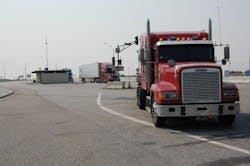[Click here to read the entire thing.]
All combined, those 51 trucking companies clocked over 5.3 billion miles and generated more than $11.9 billion in total revenue in 2014.
So what can be gleaned from reviewed the information provided by those trucking firms, most of which are defined as “large carriers”?
Here are just some of the main findings:
- Large carriers have the highest rate per mile (RPM), despite also having the longest length of haul (LOH). Large carriers posted a RPM of $2.28, compared to $2.00 for medium carriers and $1.96 for small carriers. The average LOH was 600 miles for large carriers, 506 miles for medium carriers and 388 miles for small carriers.
- Large carriers are doing a better job of retaining drivers after the first year. Large carriers have more driver turnover overall, but after the first 12 months they retain more of their drivers than both medium and small carriers.
- Large carriers (more than 500 trucks) are getting the highest revenue per driver. Large carriers in the study averaged $235,605 per driver, while for medium (101 to 500 trucks) and small (100 trucks or less) carriers, the figures were $223,075 and $211,395 respectively.
“The results from this year’s survey indicate that large carriers are leading the field in terms of rate per mile, long-term driver retention and revenue per driver,” noted Tim Almack, partner-in-charge of KSM’s Transportation Services Group. “By analyzing the correlations between carrier size and certain performance metrics, our findings provide clues on how the large carriers are mastering the game.”
Though the survey did not examine at driver pay, it did cough up some other interesting trend lines all carriers might consider:Though large carriers suffer higher levels driver turnover, they are doing a better job of retaining drivers after the first year. In fact, they retain more drivers after the first year than either medium or small carriers. KSM thinks efforts by many large carriers to increase pay may be a factor, though again the firm stressed its study did not track wage metrics, but emphasized that equipment age may play a role. The average age of tractors for large carriers is 2.02 years, according to KSM’s data, while it sits at 3.21 years for medium carriers and 2.90 years for small carriers.
Large carriers are successfully avoiding the concentration of too much business among a small handful of customers or in a limited set of lanes. For small carriers, 63% of their revenue comes from their top five customers, while for medium carriers, it is 65%. Large carriers, by contrast, rely on their top five customers for only 28% of their freight. "Being less dependent on any one customer may make it easier to decline the less profitable freight,” KSM extrapolated, noting that perhaps large carriers are doing a better job of selecting the freight that fits their needs. “The takeaway here may be that small and medium carriers would gain from negotiating more aggressively on rates and being more willing to decline freight if the rate is too low,” the firm said.
Interesting findings, for sure. The trick now, of course, is for carriers to use that information to better solidify their bottom lines going forward.





